
2021/22 Annual Report
BC Forest Practices Board
About The Forest Practices Board
Our Mandate
The Forest Practices Board (The Board) serves the public interest as the independent watchdog for sound forest and range practices in British Columbia.
Our work encourages:
- Sound forest and range practices that warrant public confidence
- Fair and equitable application of the Forest and Range Practices Act (FRPA) and the Wildfire Act
- Continuing improvements in forest and range practices
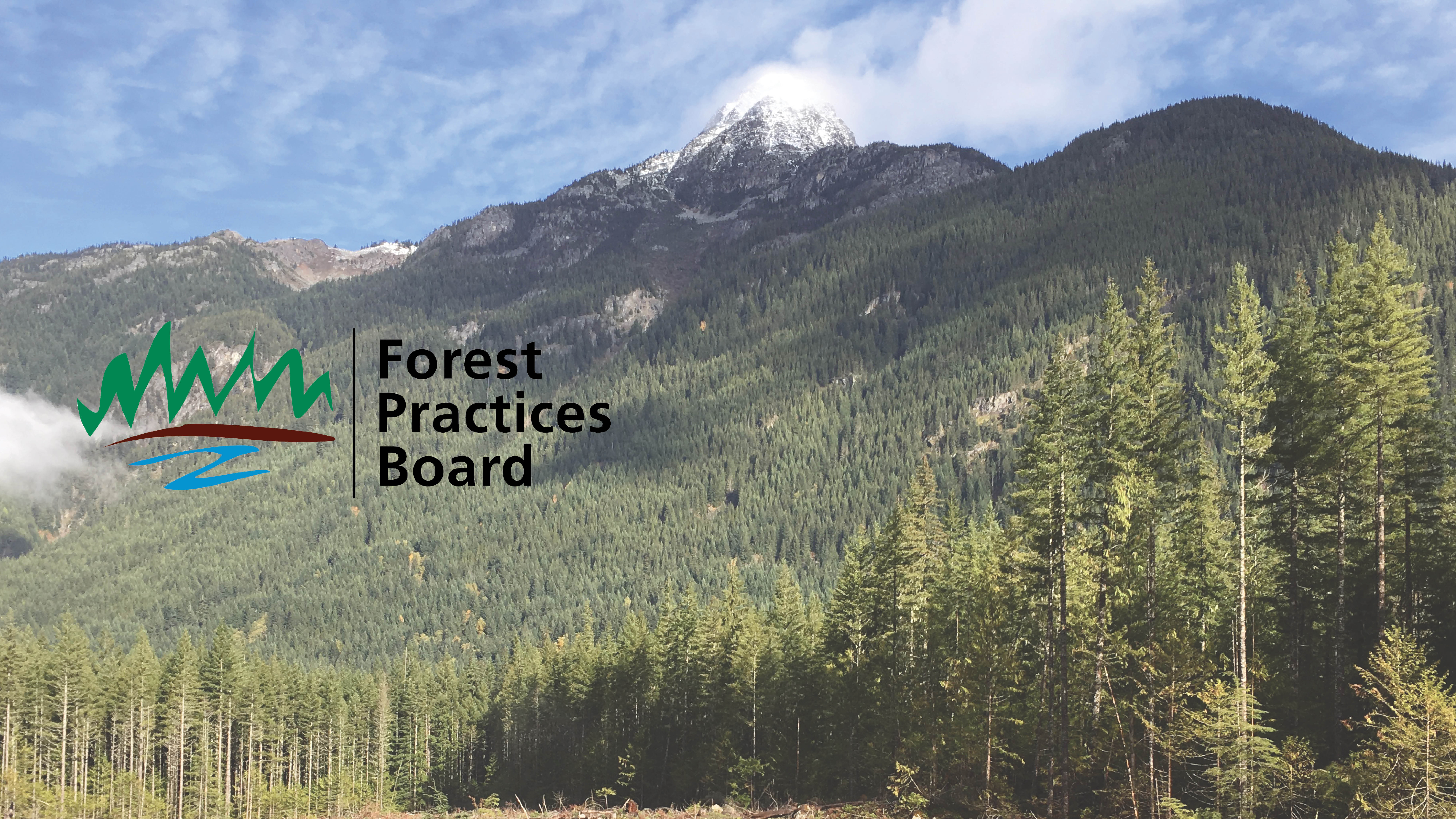
Our Values & Behaviours
These values and corresponding behaviours guide us in all of our work.
INDEPENDENCE
- Act on behalf of the public interest, not any single group
- Perform in a non-adversarial, unbiased, non-partisan and balanced manner
INTEGRITY
- Be straightforward in approach—tell it like it is
- Base actions and decisions on knowledge, evidence, experience and common sense
EXCELLENCE
- Produce high-quality work
- Seek continuous improvement—both in our work and in forest and range practices
FAIRNESS
- Treat all people with respect, fairness and sensitivity
- Seek solutions rather than assigning blame
TRANSPARENCY
- Provide clear and concise reports to the public
- Be accessible and accountable
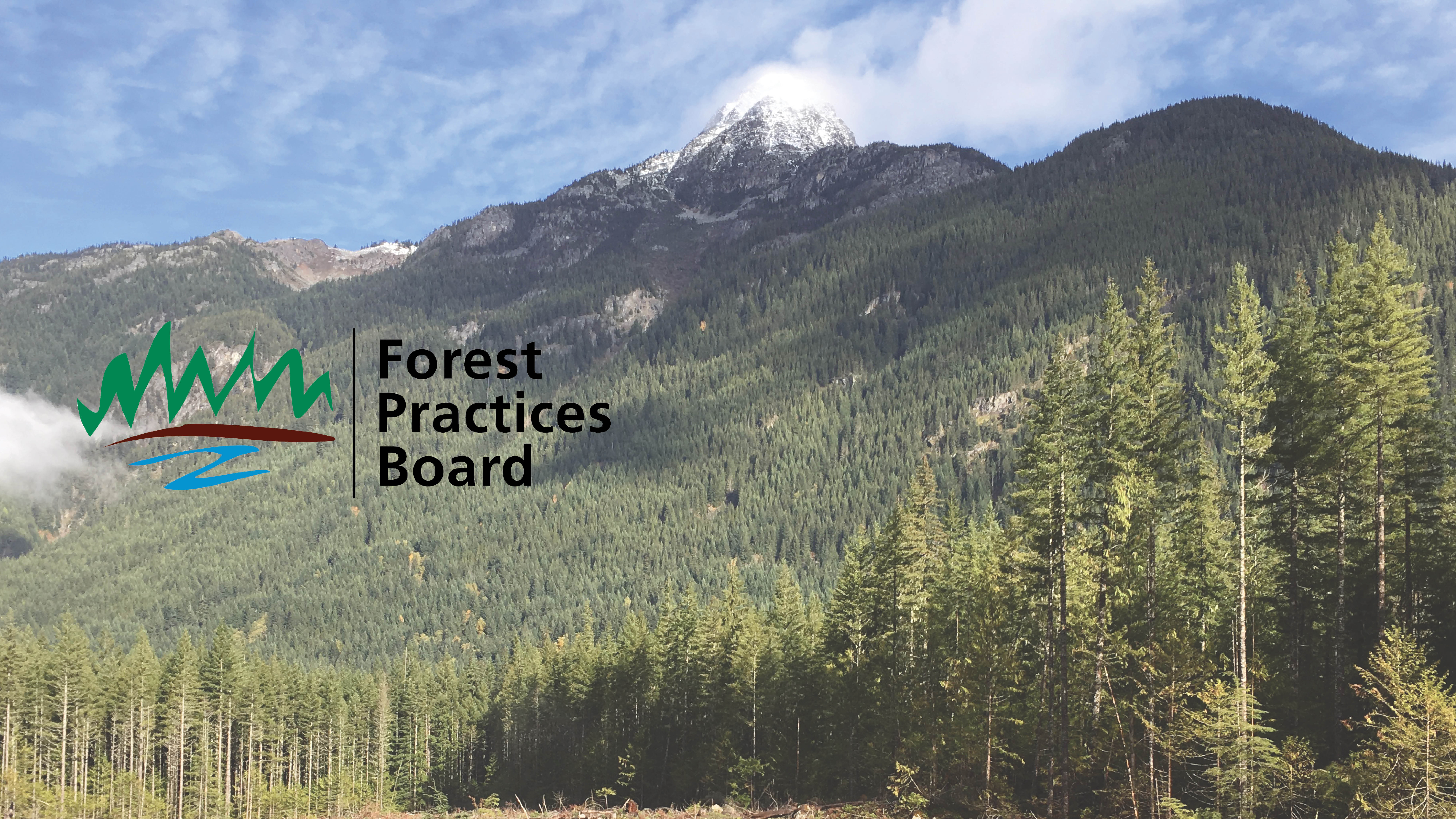
The Board acknowledges and respects the deep connection Indigenous Peoples in British Columbia have with the land and the knowledge they hold about the land. The Board wishes to expand our knowledge and learn from Indigenous Peoples. We are also taking steps to engage with Indigenous communities and develop new relationships.
Message from the Chair
Board Chair, Kevin Kriese presenting his annual message.
Transcript
Hi, I'm Kevin Kriese, chair of the Forest Practices Board.
There's a lot of discussion in BC about paradigm shifts, and I think in BC there's actually two different paradigm shifts for forestry under way at the same time. The first is to better address Indigenous interests and rights and move towards reconciliation. The second paradigm shift is about how we actually manage our forests to better reflect ecosystems, ecosystem health, and the services that they provide.
Here at the Board, our work also reflects these shifts that are under way. With respect to reconciliation, the Board has changed how we approach Indigenous people to basically involve them much earlier in any processes that we undertake. Early engagement is a door opener. It allows us to have a conversation with an Indigenous community about the work we're doing and about the values that they see, before we initiate a project. I want to thank the communities who responded to this open door in the past year. Every conversation we had with you was rich and helped us better understand your values and will make our work better.
With respect to the changes on how we manage our resources and our land, the Board issued a report last year on opportunities to improve forest practices for water. In it, we identified four opportunities for change. We encourage the province to adopt all four of these recommendations as part of its Watershed Security Strategy.
Another highlight for the past year was the introduction of changes to the Forest and Range Practices Act. A number of these changes reflect recommendations the Board has made in the past. Perhaps the most significant change is the shift away from a regime of forest stewardship plans, towards a regime based on forest landscape plans. Forest landscape plans will fundamentally alter how Indigenous people are involved in planning the forests in their territories, based on a model of seeking consent.
In the coming year, the Board has initiated a project to look at managing for fire at the landscape level, which will be one of the places where we try to influence how landscape planning can be successful in addressing the risks we see into the future from climate change.
This will be my last annual report as chair of the Forest Practices Board. It's been an honor to serve for the past four years. I want to recognize the amazing staff and appointed Board members who make all of our work successful. I also want to thank members of the public, licensees, and government who provide us your advice, your thoughts, and your views on what we should do and how we should do it.
Your advice and interests make all of our work better. Improving forest practices is a team effort, and we couldn't do it without your support. Thank you.
Our Board Members
(From left to right) Rick Monchak, Gerry Grant, Kevin Kriese, Gail Wallin, Cindy Stern, and Bruce Larson.
The Board consists of the full-time Chair and five part-time members, who live in communities across the province. There were no changes to Board membership during the year. Board Chair Kevin Kriese announced he will be retiring at the end of June 2022, and the chair recruitment process began in March 2022.
The Board met once in person in 2021/22 for a field trip. In addition to the field trip, the Board members met by video call each month except August.
Campbell River and Quadra Island Field Trip
Throughout the year, the Board seeks opportunities to enage with communities and stakeholders to learn and understand what values are top of mind. The Campebll River and Quadra Island field trip served as an opportunity to hear from local licensees and Indigenous communities.
In early September, the Board members and a number of staff traveled to Northern Vancouver Island for a meeting and field trip. Activities included:
- discussing old-growth management with Western Forest Products staff;
- visiting an innovative woodlot on Quadra Island;
- meeting Nanwakolas Council representatives to discuss cultural stewardship; and
- learning about Interfor's strategies for Indigenous participation in forest management.
It was a very worthwhile two days that allowed the Board to get out on the ground, engage with forestry specialists, and hear perspectives on some significant forestry issues facing BC today.
See the graphic below for a list of key stakeholders the Board met with during the year.
Highlights of the Board's work this year (Click to Enlarge)
2021/2022 Financial Report
(Click to Enlarge)
Table Notes:
- "Board Members and Executive" expenditures cover those of the Board Chair, the part-time Board members, the office of the Executive Director, and staff providing direct support to the Board members.
- "Legal" expenditures cover legal services including legal advice on all Board files and conducting of reviews and appeals.
- "Administration and Overhead" includes building occupancy charges, software licensing, centralized support charges, and salaries associated with support for corporate services and information systems.
Strategic Plan Update
The Board is currently operating under its 2019-2022 Strategic Plan. In January 2022, as part of the annual planning cycle, the Board reviewed the status of the implementation of the strategic plan, along with an environmental scan of what is happening across the sector. The Board extended the plan to March 2023, to allow time for development of a new plan with a new Board Chair.
The Board identified three strategic priorities for the fiscal year 2022/23:
1) Strengthen engagement with Indigenous communities by undertaking proactive and relationship-based engagement that is embedded throughout the Board.
Actions taken:
- Increased our engagement with Indigenous communities in our reports, investigations, audits, and special projects
- Met with Indigenous communities and representatives to discuss the Board's role and the work it does, and how that can involve Indigenous communities
- Developed a digital story to illustrate our programs through examples of past work with Indigenous Communities
2) Increase impact through a robust program of special projects that help inform the evolution of new forest practices envisioned through the changes in FRPA.
Actions taken:
- Initiated two new special projects on topics of broad public interest – Measuring and Allocating Forage on Rangelands Special Report, and the Landscape Fire Management Special Report
- Completed reports on water and recreation – two topics of significant public interest – with ideas for informing forest landscape plans to improve practices
3) Increase impact through an expanded and enhanced communication program that maximizes the audience when reports are complete.
Actions taken:
- Published water special report and participated in a number of meetings and webinars to share the findings
- Participated in webinars to share findings of the recreation special report
- Participated in a webinar to highlight two complaint reports involving management of habitat for fisher – a species at risk
A total of 7 new recommendations were made in 2 published reports. The Board received responses to 9 recommendations during the year, of which 7 were accepted and/or implemented.
Audits
The Board audits forest and range practices on public lands and the appropriateness of government enforcement. Auditors objectively collect and evaluate evidence to determine if forestry and range activities are consistent with FRPA, the Wildfire Act, and operational plans, ensuring that practices are consistent with government objectives for forest resources.
Accomplishments
As part of our efforts to increase the value of our compliance audits, we continued to implement an enhanced audit checklist to identify practices that go beyond minimum legal requirements, and 8 auditees completed the checklists in 2021.
This year, we completed and published 1 audit that started in 2020. 8 new audits were conducted in 2021 with 2 published this fiscal year. Audits took place throughout BC, covering both area and volume-based tenures, ranging in size from community forest licences to large timber supply areas.
Of the published audits, 1 had no findings, 2 had areas for improvement in Silviculture Reporting, and 1 had an area for improvement in Fire Hazard Abatement.
Compliance Audits in Progress (as of March 31, 2022)
- Cheakamus Community Forest K3V, Sea to Sky
- Range, Multiple Tenures, Quesnel
- Gitxsan Forest License Inc, Skeena
- Canfor, Forest Licence A15384, Mackenzie
- BCTS and TSL holders, Terrace field unit
- BCTS and TSL holders, Columbia field unit
Audit Season Statistics
Road and bridge numbers are approximate.
Map of roads audited (Click to Enlarge)
DM Obligations on FSRs - Okanagan Shuswap Natural Resource District
Map of areas audited (Click to Enlarge)
Kalesnikoff Lumber Co. Ltd, FL A20194
Map of areas audited (Click to Enlarge)
Taan Forest Ltd. Partnership & Taan Forest Ltd, TFL 60 and FLC A87661
Complaint Investigations
The Board investigates public complaints about compliance with FRPA and the Wildfire Act, and appropriateness of government enforcement. The Board can investigate complaints related to activities occurring on public land, including forest stewardship plans; site plans and woodlot licence plans; forest practices; range plans and practices; protection of resources; and government enforcement.
Accomplishments
One of the Board’s strategic priorities is to continuously improve existing work. In spring 2021 the Board completed a review of its complaint investigation process and began to implement the results. The new process is aimed at improving timeliness, increasing Board Member involvement, and adopting a mindset of continuous improvement. All complaints received since April 1, 2021 are following the revised process. The Board is monitoring progress and adapting as necessary as investigations proceed. Part of the continuous improvement process is to review completed files with an eye towards improving future investigations. While it will take time for a reasonable number of investigations to be completed and the results evaluated, initial impressions are promising.
The Board completed and published 7 complaint investigations and received 6 new complaints. Staff responded to a total of 80 public concerns. 10 complaints and 8 concerns from 2020-21 were carried over into 2021-22. As of March 31, 2022, 7 complaints and 2 concerns are ongoing.
New Complaints Received
Grazing Practices at Blue Lake The complainants are concerned that grazing activity at Blue Lake and a nearby pond in the South Okanagan Grasslands protected area has destroyed riparian vegetation. - Status: Active -
Road Impact to Water Quality Near Avola Two residents claimed that a road built to access a timber sale is contributing sediment to their water intake, rendering the water undrinkable. - Status: Active -
TSL TA0021 Sunshine Coast The complainant is concerned about the impacts of clearcut logging and road building on hydrological integrity, and the improper management of excessive slash on a timber sale. - Status: Active -
Imcommappleux FSR Closure The complainant is concerned that the closure of the Imcommappleux Forest Service Road for safety reasons means she cannot access her property. - Status: Closed. The complaint was not within the jurisdiction of the Board to investigate. -
Visual Quality Objectives on Woodlot 1898 The complainant is concerned about the appropriateness of government enforcement related to achieving visual quality objectives on WL 1889. - Status: The Chair decided to stop the investigation in accordance with section 123(2)(b) of FRPA. An ongoing compliance and enforcement investigation provides a remedy adequate in the circumstances to address the complaint. -
Government Enforcement & Woodlot 2031 The complainant is concerned that government enforcement was inappropriate regarding the harvest of old growth on WL 2031. - Status: Active -
Published Complaint Investigations
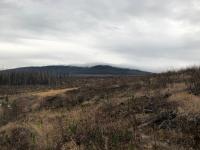
Logging in Fisher Habitat
Logging in Fisher Habitat. Click to expand.
An investigation of a complaint by a trapper found that habitat for the fisher–a fur-bearing mammal that is a species at risk in BC – is at risk of decline near Bobtail Mountain Park southwest of Prince George. The trapper complained to the Board that three cutblocks proposed by Canfor were the last remaining fisher habitat in his trapline, and he wanted them retained. Fisher habitat includes older forest stands with large trees, snags and coarse woody debris. Fishers prefer landscapes with large areas of connected forest and avoid non-forested openings.
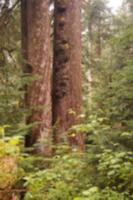
Compliance with Biodiversity Requirements in the Nahmint Watershed
Compliance with Biodiversity Requirements in the Nahmint Watershed. Click to expand.
The investigation of a complaint about BC Timber Sales’ (BCTS) logging of large old growth trees in the Nahmint River Watershed found that BCTS’s forest stewardship plan (FSP) was not consistent with the Vancouver Island Higher Level Plan Order (HLPO) and did not adequately protect old forest and biodiversity values in some ecosystems. The complaint was triggered when Ancient Forest Alliance members saw BCTS licensees harvesting large old trees in 2018. They also raised concerns about the adequacy of a government investigation of the matter. The Board found that government’s investigation was reasonable. However, it also found that the current legislation limits the ability to enforce the provisions of the HLPO. In its FSP, BCTS committed to conserving a minimum amount of old forests in biogeoclimatic zone variants, but the HLPO required it to conserve old forest in each site series – a finer scale of classification that captures a wider range of the diversity of ecosystems found in the area. The report recommended that government complete landscape unit planning to specify the amounts of forest to retain in each site series and that BCTS amend its FSP to achieve the HLPO legal objectives. It also recommended BCTS ensure it does not sell any timber sales in these high-risk ecosystems until a landscape unit plan is completed. Ministry staff agreed with all of the recommendations made in this report. Specifically, BCTS drafted a landscape unit plan and a new FSP strategy that intend to achieve the old-growth representation requirements defined in the HLPO. BCTS also committed to not developing or selling timber on sites that are inconsistent with the new landscape unit plan while awaiting the plan’s approval. The ministry is also exploring options to allow for the correction of errors in FSPs beyond the first 60 days following their approval.
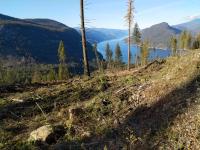
Motorized and Industrial use of the Columbia and Western Rail Trail
Motorized and Industrial use of the Columbia and Western Rail Trail. Click to expand.
The complainant was concerned that motorized use was changing the character of the Columbia and Western Rail Trail (CWRT), and preventing the public from enjoying a safe recreational experience. The Board found that, although certain public user groups believed the CWRT was intended to be a non-motorized recreation trail, government did not restrict motorized access.

Colocation: TFL 44
Colocation: TFL 44. Click to expand.
A complaint was received regarding the process of colocation in TFL 44. Colocation is the practice of designating mandatory wildlife tree retention areas within already protected (reserved from harvest) wildlife habitat areas to reduce the impact on timber supply. This practice is not prohibited under FRPA and is actually encouraged under the most current wildlife tree retention guidance. The investigation found the licensee to be exceeding requirements for wildlife tree retention in the six blocks examined.

Rose Swanson Mountain
Rose Swanson Mountain. Click to expand.
The Board received a complaint that BC Timber Sales’ (BCTS) 2012-2018 and 2018-2023 Okanagan-Columbia Forest Stewardship Plans (FSP) are not consistent with the 1996 Order to Establish a Sensitive Area and Objectives (Order) for Rose Swanson Mountain. The investigation found that BCTS’s 2012-2018 FSP was in fact consistent with the Order, but its 2018-2023 FSP was not.
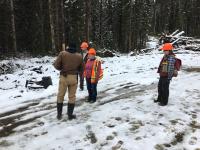
Management of Furbearer near Windy Mountain
Management of Furbearer near Windy Mountain. Click to expand.
An investigation of a complaint by a trapper found that BC Timber Sales (BCTS) is meeting government’s expectations to manage habitat for furbearers. The trapper was concerned that timber harvesting is removing habitat for furbearers and is affecting his ability to make a living. While the trapper believes there should not be any more harvesting permitted in his trapline, he consulted with BCTS and provided input to the planning process, which was accepted.
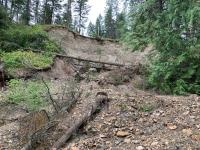
Impacts of Wildfire and Harvesting Near Silver Hills
Impacts of Wildfire and Harvesting Near Silver Hills. Click to expand.
Silver Hills Watershed Watch complained that Tolko Forest Industries Ltd.’s (Tolko) forest harvesting over the past few years between Lumby and Cherryville increased water flows, contributed to four landslides, and introduced sediment into streams that supply drinking water. Tolko harvested one cutblock in 2015 and then salvage-harvested a second cutblock following a wildfire in 2018. In May 2020, four landslides occurred below the harvested areas, affecting McPherson Creek, which supplies residents’ drinking water.
Special Projects
The Board undertakes special projects to examine trends identified in audits or investigations and issues of public interest that cannot be addressed through other work. Special projects are guided by the Board’s strategic priorities, as identified in its Strategic Plan.
Accomplishments
2 special projects were concluded this year and 2 new projects were started. 2 ongoing projects are nearing completion.
The Board's 2019-22 strategic plan includes a strategic priority of preparing for the future, by increasing our focus on climate change, tactical planning, and increased effectiveness monitoring. This year, the Board completed a detailed review of candidate climate change special projects. A number of projects under the themes of wildfire, forest regeneration and water were evaluated. Pre-project development included work with various agencies, organizations and experts – contributing to an assessment of what topics may be most useful for policy makers, practitioners or the public. A new project: Landscape Fire Management, came out of this work.
Special Projects in Progress (at March 31, 2022)
SPECIAL REPORTS
Measuring and Allocating Forage on Rangelands in BC This special report will determine if government has a credible and systematic approach to meaure and allocate forage on rangelands without causing damage to FRPA values. Those values include riparian areas, wildlife habitat and soils, and Indigenous interests. The special report will examine how well this process contributes to achievement of government's objectives for range contained in the Range Planning and Practices Regulation.
Landscape Fire Management This special report will identify fundamental principles of landscape fire management with a goal of sustaining resilient ecosystems. Advocating for the importance of wildfire as a consideration in all aspects of forest management, the report will identify criteria to achieve the principles relative to forest and range planning and regionally appropriate practices.
SPECIAL INVESTIGATIONS
Wildfire Act Determinations This special investigation will assess whether Wildfire Act determinations are appropriate (consistent, fair, and timely). The review will also identify policy issues, such as how the regime addresses the public interest in hazard abatement.
Protection of Species at Risk Under FRPA: Northern Goshawk This special investigation will assess if the mechanisms available under FRPA and associated IWMS guidance are adequate for maintaining species at risk habitat. Northern Goshawk is being used as a case study to evaluate both legal and voluntary measures to maintain suitable habitat for Northern Goshawk and their prey on the coast and in the interior.
Special Projects Published
Management of Forest Recreation in BC
The Board wrote this special report after receiving many concerns and complaints over the last few years about forest recreation activities and how they are affected by forestry activity. The report describes how the FRPA framework addresses management of forest recreation and identifies the strengths and weaknesses of the FRPA framework for forest recreation management. Through reviews of policy, forestry plans, interviews with forest recreation groups, government staff, forest industry staff, commercial recreation operators, and field visits, the Board identified a variety of issues. Most issues resulted from a lack of planning, or gaps in planning for a recreation resource value.
In the report, the Board identifies three primary areas for improved recreation management:
- improve information available for recreation resources;
- increase planning efforts including collaboration among stakeholders; and
- improve the use of government objectives for recreation resources.
Forest Practices and Water: Opportunities for Action
This report was a 15-year retrospective look at water-related projects undertaken by the Board. These included 27 complaint investigations, 8 special projects and 3 compliance audits with findings related to the effects of forestry on water. These investigations and audits mostly found industry complying with legal requirements to protect water resources.
Despite high degrees of compliance, four main themes emerged:
- the public does not have adequate opportunity for meaningful involvement in how forest practices occur in relation to water and risk to values;
- there are no legal requirements to assess or consider cumulative effects of forest practices in most watersheds in BC;
- current forest practices contribute sediment into streams; and
- historical forest practices continue to negatively affect water.
The Board found that many of these issues stem from current regulations’ focus on managing for water on a site-by-site basis, with less than 10 percent of the province having requirements to manage for cumulative effects at the watershed level. The Board prepared this special report as advice to government relevant to three initiatives—the creation of a Watershed Security Strategy and Fund, modernization of BC’s forestry legislation, and development of a Climate Preparedness and Adaptation Strategy.
The report identifies four opportunities for improvement:
- making water a core value in forest planning, including the new forest landscape planning process;
- creating a legal requirement to manage cumulative effects of forestry in all watersheds;
- improving regulation of forest practices that contribute sediment to streams; and
- renewing watershed restoration efforts to reduce the impact of historical forest practices.
The Board participated in 2 webinars on the report, and also met with industry, government, and NGOs interested in water to share the findings and foster discussion of water issues. As with any Board report, we encourage those interested to contact us to learn more about this report and its findings.
Appeals
The Board can participate in reviews and appeals of certain determinations made under FRPA and the Wildfire Act including contravention determinations, administrative penalties, cost-recovery orders, remediation orders and approvals and denials of forestry and range plans. The Board has the authority to request the government to review certain determinations and can initiate or join appeals to the Forest Appeals Commission. The Board can participate in reviews and appeals on its own initiative or at the request of the public.
The Board’s participation in appeals and reviews is guided by the following objectives:
Objective 1 - Join or initiate appeals where there are important issues of precedent in the interpretation of FRPA or the Wildfire Act.
Objective 2 - Join or initiate appeals where there are important issues of administrative justice in the application of FRPA or the Wildfire Act, such as the appropriateness of administrative penalties, or procedural fairness.
Accomplishments
The Board reviewed 34 FRPA and Wildfire Act determinations. We also initiated 1 appeal to the Forest Appeals Commission and joined 2 others. This year, we requested 1 ministry review of a determination.
Appeal Cases
Unauthorized harvest
The Board appealed the penalty amount in a determination that found the holder of a forestry licence to cut in contravention of FRPA for cutting and removing Crown timber without authorization. The licence holder only harvested cedar and cypress from outside of the licence boundaries. The Board believes that the $12,000 penalty amount is too low in the circumstances. The Board will argue in this appeal that the licence holder deliberately contravened FRPA and derived an economic benefit from the contraventions. The penalty amount should be increased to ensure that it removes the economic benefit and deters the licence holder from similar conduct in the future. This appeal is in writing. The Board submitted its written materials in June, 2022 and the other parties have until mid-July, 2022 to submit their materials.
Biodiversity value of Crown timber
The Board joined an appeal in which the licence holder, who was found in contravention of FRPA for harvesting Crown timber from outside of the licence boundary, is challenging the penalty amount. One of the issues in the appeal is the biodiversity value of the trees damaged, destroyed or lost from the contravention and how that informs the appropriate penalty amount. The Board intends to argue that administrative penalties should compensate the government for the biodiversity value of the trees in question. The Board also intends to propose principles that should apply when assigning a monetary value to trees that added biodiversity value to the ecosystem. The appeal is ongoing with no hearing date scheduled yet.
Debris pile burning and the defence of due diligence
The Board joined an appeal of a determination that found the forest licensee in contravention of the Wildfire Act and Wildfire Regulation for failures related to debris pile burning. The Board intends to focus its participation in this appeal on the standard of diligence that licensees who conduct debris pile burning should be required to demonstrate to establish a statutory defence of due diligence. The appeal is scheduled for a two week oral hearing in November 2022.
Review Cases
Multiple administrative penalties for one wrongful act
The Board reviewed a determination that found a woodlot licence holder in contravention of FRPA for failing to comply with a commitment in a woodlot licence plan to achieve the applicable visual quality objective in a cutblock. The determination also found the licensee in contravention of the Woodlot Licence Planning and Practices Regulation for failing to achieve the applicable visual quality objective. The determination levied a penalty for both contraventions. In the Board’s view, the determination unfairly levied multiple penalties for one wrongful act of failing to achieve the visual quality objective. The Board is authorized under FRPA to require the government to review a determination with the consent of the person who is subject to the determination. Here, the woodlot licence holder consented and the Board required the government to review the determination. A district manager for the ministry is in the process of reviewing the determination and will issue a review determination in time.
Communications
At the Board, we continued to participate in virtual meetings, events, and conferences. We built on the success of last year, organizing and participating in webinars, and attending conferences and events. Stakeholder meetings as well as First Nations engagement successfully continued in an online format for much of the year. We also made progress on two strategic priorities through the development of an Indigenous Engagement Guidance document for staff; engagement with First Nations organizations and communities; and by improving our reports' reach through expanded distribution, webinars and presentations. In 2022, in-person gatherings started to resume. Although we have succeeded in adapting to an online format, we are looking forward to engaging in person again.
Accomplishments
This Year's Publications
This year we published 12 reports. We recorded 4,160 total report downloads from our website. Our top 5 most popular reports were:
- Compliance with Biodiversity Requirements in the Nahmint Watershed
- Management of Forest Recreation in BC
- Logging in Fisher Habitat near Prince George, BC
- Forest Practices and Water: Opportunities for Action
- Motorized and Industrial use of the Columbia and Western Rail Trail
(Click to Enlarge)
Our new website. (Click to enlarge)
Website data
This year saw more growth for our website. Late in the fiscal year, our refreshed website went live, featuring streamlined navigation and additional features.
Social Media
2021/22 was another year of growth across our social media platforms. We look forward to continuing to connect with the public while exploring new ways of sharing our reports and information.
Contact Us
We encourage those interested to contact us to learn more about our work. We would be pleased to answer your questions and provide additional information, whether by phone, meetings, webinars, or by giving presentations on our reports and our work.
Do you have a concern about forest and range practices in BC? Call or email us to speak to an investigator.